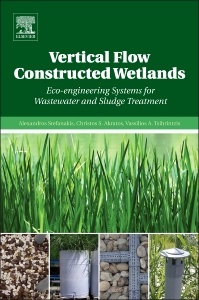Description
Vertical Flow Constructed Wetlands
Eco-engineering Systems for Wastewater and Sludge Treatment
Authors: Stefanakis Alexandros, Akratos Christos S., Tsihrintzis Vassilios A.
Language: English
Subject for Vertical Flow Constructed Wetlands:
146.54 €
In Print (Delivery period: 14 days).
Add to cart
Publication date: 01-2015
392 p. · 15.5x23.2 cm · Hardback
392 p. · 15.5x23.2 cm · Hardback
Description
/li>Contents
/li>Readership
/li>Biography
/li>Comment
/li>
Vertical flow constructed wetlands for wastewater and sludge treatment represent a relatively new and still growing technology. Vertical Flow Constructed Wetlands is the first book to present the state-of-the-art knowledge regarding vertical flow constructed wetlands theory and applications. In this book, you will learn about vertical flow systems with information about application and performance. Vertical Flow Constructed Wetlands also includes information on how different countries are applying the technology, with design guidelines to illustrate best practices worldwide. A focus on water conservation through reuse of treated water showcases the benefit of vertical flow construction, which has greatly increased the attractiveness of the technology in recent years.
Chapter 1: IntroductionChapter 2: Theoretical BackgroundChapter 3: Vertical Flow Constructed WetlandsChapter 4: Sludge Treatment WetlandsChapter 5: EconomicsChapter 6: Life Cycle AnalysisChapter 7: System Operation, Maintenance, and ManagementChapter 8: Design Examples and Case StudiesChapter 9: General Aspects of Sludge ManagementChapter 10: Sludge Treatment Wetlands - Basic Design ConsiderationsChapter 11: Processes and Mechanisms of Sludge DewateringChapter 12: Performance of Sludge Treatment WetlandsChapter 13: Techno-economic Aspects of Vertical Flow Constructed WetlandsReferences
Environmental scientists and engineers, researchers in wastewater treatment, Wastewater/Water Treatment Plant Operators and Contractors, Sustainable wastewater/water managers, NGOs
Alexandros I. Stefanakis is Assistant Professor at the School of Chemical and Environmental Engineering, Technical University of Crete, Greece. His expertise lies in ecological engineering and technology, specifically in nature-based solutions for sustainable water and wastewater management. He is known as an expert and enthusiast of the green technology of constructed wetlands. He studies and investigates the role of nature-based solutions in a circular water economy.
Dr. Christos Akratos received his diploma and doctoral degrees from the Department of Environmental Engineering, Democritus University of Thrace, Greece, and now is a Lecturer at the Department of Environmental and Natural Resources Management, University of Western Greece. Dr. Akratos has a great experience in constructed wetlands starting from his doctoral dissertation, and the majority of his publications deal with wastewater treatment with constructed wetlands. He has published 21 refereed journal papers, and has participated as a research team member in 14 research programs, most of them in the area of wastewater treatment in constructed wetlands.
Dr. Vassilios A. Tsihrintzis is a Professor of Ecological Engineering and Technology and Director of the Laboratory of Ecological Engineering and Technology of the Department of Environmental Engineering, Democritus University of Thrace, Xanthi, Greece. He is a civil engineer and has M.Sc. and Ph.D. degrees in Environmental Engineering from the University of Illinois at Urbana-Champaign. Dr. Tsihrintzis’ research interests concentrate, among others, in the fields of natural systems for wastewater treatment with emphasis on constructed wetlands and water resources engineering and management. His published research work includes more than 100 papers in peer-reviewed scientific journals and over 250 papers in conferences. He has also authored or co-authored books/book chapters on operations research, urban hydrology and runoff quality management, an
Dr. Christos Akratos received his diploma and doctoral degrees from the Department of Environmental Engineering, Democritus University of Thrace, Greece, and now is a Lecturer at the Department of Environmental and Natural Resources Management, University of Western Greece. Dr. Akratos has a great experience in constructed wetlands starting from his doctoral dissertation, and the majority of his publications deal with wastewater treatment with constructed wetlands. He has published 21 refereed journal papers, and has participated as a research team member in 14 research programs, most of them in the area of wastewater treatment in constructed wetlands.
Dr. Vassilios A. Tsihrintzis is a Professor of Ecological Engineering and Technology and Director of the Laboratory of Ecological Engineering and Technology of the Department of Environmental Engineering, Democritus University of Thrace, Xanthi, Greece. He is a civil engineer and has M.Sc. and Ph.D. degrees in Environmental Engineering from the University of Illinois at Urbana-Champaign. Dr. Tsihrintzis’ research interests concentrate, among others, in the fields of natural systems for wastewater treatment with emphasis on constructed wetlands and water resources engineering and management. His published research work includes more than 100 papers in peer-reviewed scientific journals and over 250 papers in conferences. He has also authored or co-authored books/book chapters on operations research, urban hydrology and runoff quality management, an
- All state-of-the-art knowledge regarding vertical flow constructed wetlands gathered in one book
- A review of various constructed wetland approaches, including information about applications and performance, helps clarify what is currently known about constructed wetland principles and design
- Discussion of how to manage the treated wastewater leaving the vertical flow for increasing biodiversity, providing food and habitat for birds, and producing harvestable biomass or crops
- Includes case studies of constructed wetlands in developing countries
© 2024 LAVOISIER S.A.S.




